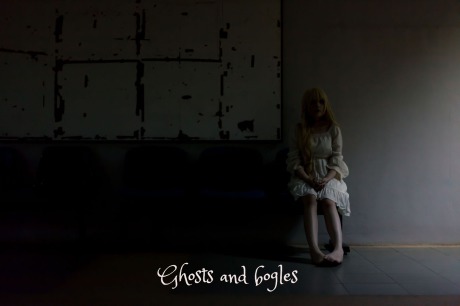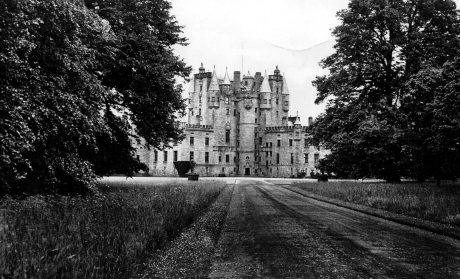The Many Ghosts of Glamis
Glamis Castle is a magnificent castle and stately home, but it is probably best known, perhaps a little unfairly, for its multitude of ghosts rather than the magnificence of the building.
The huge tower of Glamis has walls up to fifteen-foot thick and a stair of one hundred and forty-three steps. Glamis is mentioned in Shakespeare’s Macbeth, but any association (as Cawdor) with the present castle is from the play as Glamis is not mentioned in records or histories until 1264.
The castle and lands have been held since the fourteenth century by the Lyon family, now Bowes-Lyon, Earls of Strathmore and of Kinghorne. Elizabeth Bowes-Lyon, who died in 2002, sprang from the family and was the present Queen’s mother.
There are many ghost stories associated with Glamis. These include the apparition of a little African servant boy; a White Lady said to be seen in an avenue of trees which leads up to the castle; the ghost of a butler who hanged himself; the bogle of a tongueless woman; a phantom party of Ogilvys sealed up in a secret room at Glamis; and the spirit of a servant girl who was purported to be a vampire and drained a victim white before being walled up.
One of the most famous stories regards another sealed and abandoned chamber, where the shades of several men, including ‘Earl Beardie’, are said to be trapped forever playing cards with the Devil. It is not clear whether the main protagonist was Patrick Lyon, first Lord Glamis, who died in 1459 and may have been known as ‘Earl Beardie’, or Alexander Lindsay, fourth Earl of Crawford, who was definitely known as ‘Earl Beardie’, one of Lord Glamis’s contemporaries.
The story goes that the party is compelled to play until the ‘day of doom’ for gambling on the Sabbath and making a wager with the Devil that resulted in losing their souls. The Earl of Crawford (one story is that his own dear mother smothered her own brother so that he would succeed to the title) was certainly a cruel and ruthless character, although Patrick Lyon was reputedly little better.
One detail is that as the game progressed, a servant put his eye to the keyhole of the door – and was forever blinded in that eye.
The story then goes that such disturbance and noise issued from the chamber that eventually it was locked up and people feared to enter there This did not, however, entirely solve the problem and unexplained sounds still plagued Glamis.
The following comes from a book of 1875, called Glimpses of the Supernatural:
‘There is no doubt about the reality of the noises at Glamis Castle. On one occasion, some years ago, the head of the family, with several companions, was determined to investigate the cause. One night, when the disturbance was greater and more violent than usual, and it should be premised strange, weird and unearthly sounds had often been heard, and by many persons, some quite unacquainted with the ill repute of the Castle, his lordship went to the haunted room, opened the door with a key, and dropped back in a dead swoon into the arms of his companions; nor could he ever be induced to open his lips on the subject afterwards.’
A further excerpt from that work may be related, also believed to be associated with ‘Earl Beardie’:
‘A lady and her child were staying for a few days at the Castle. The child was asleep in an adjoining dressing room, and the lady, having gone to bed, lay awake for a while. Suddenly a cold blast stole into the room, extinguishing the night light by her bedside, but not affecting the one in the dressing-room beyond, in which her child had its cot. By that light she saw a tall mailed figure pass into the dressing-room from that in which she was lying. Immediately thereafter there was a shriek from the child. Her maternal instinct was aroused. She rushed into the dressing-room and found the child in agony of fear. It described what it had seen as giant who came and leant over its face.’
This is apparently not the only time that this had happened: other children staying in the upper rooms of the castle reportedly woke to find a huge bearded phantom leaning over the beds and observing them.
Another story regards Lady Janet Douglas, the beautiful widow of John Lyon, sixth Lord Glamis. Janet had a son by John (also called John), and later married Walter Campbell of Skipness. She was also the sister of Archibald Douglas, fifth Earl of Angus, and was hated, along with the rest of her family, by James V. James had been ill treated and imprisoned in his youth by the Earl of Angus, who had also married his mother, Margaret Tudor, after the death of his father James IV at the disastrous battle of Flodden in 1513. The Earl of Angus virtually ruled the kingdom. James V eventually escaped his clutches and asserted his rule. And, although James besieged the outlawed Earl of Angus in Tantallon Castle in 1528, the Earl fled and escaped his clutches: Janet was not to be so lucky.
Janet, who was about thirty-two at the time, was accused of treasonably communicating with her exiled brother (which she may well have done) but she failed to appear on this charge. The king’s forces then besieged Glamis and Janet was seized, along with her son and husband. All three were brought to Edinburgh Castle and there imprisoned for weeks in a dark pit.
Janet was then also charged with both trying to poison the king and of being a witch, accusations which were undoubtedly false. The young woman, of good and upright character, defended herself eloquently, but it was to no avail: she was burned alive (the punishment for treason) on Castle Hill in Edinburgh on the 3rd of December 1537. She had been imprisoned with her husband and her son John for so long that she had nearly gone blind. Her family was forced to watch the execution.
One description of her says:
‘She was in the prime of her life, of a singular beauty, and suffering through all, though a woman, with a man-like courage.’
Glamis was forfeited to the Crown, and John, her orphaned son, was also sentenced to death, although he was too young at the time for the execution to proceed.
Her husband Walter tried to escape from the castle but fell down the rock and was killed. Luckily for her son John, James V died in 1542 and John was pardoned. He went on to inherit his father’s property, including Glamis Castle, although the castle had been ransacked and looted by the king’s men.
Janet’s ghost is said to haunt the spot where she died on the esplanade outside Edinburgh Castle, but also reputedly returned to Glamis. The story is that her apparition, known as the Grey Lady (although possibly also the White Lady; however this may be an entirely different ghost), has reputedly been seen in the castle chapel as well as in the clock tower. Glamis Castle is open to the public and the chapel may be visited.
Hammering and banging, believed to come from her execution, are also said to plague the building. One account of 1880 relates:
‘A lady, well known in London Society, an artistic and social celebrity, wealthy beyond all doubts of the future, and what is called very cultivated and instructed, but clear-headed, and perhaps slightly matter-of-fact woman, went to stay at Glamis Castle for the first time. She was allotted very handsome apartments, just on the point of the junction between the new buildings – perhaps a hundred or two hundred years old – and the very ancient part of the castle. The rooms were handsomely furnished: no gaunt carvings grinned from the walls; no grim tapestry swung to and fro, making strange figures look the stranger by the flickering firelight; all was smooth, cosy, and modern, and the guest retired to bed without a thought of the mysteries of Glamis. In the morning she appeared at the breakfast-table quite cheerfully and self-possessed. To the inquiry how she had slept, she replied: ‘Well, thanks, very well, up to four o’clock in the morning. But your Scottish carpenters seem to come to work very early. I suppose they put up their scaffolding quickly, though, for they are quiet now.’ This speech produced a dead silence, and the speaker saw with astonishment that the faces of members of the family were very pale.
She was asked, as she valued the friendship of all there, never to speak to them on the subject again; there had been no carpenters at Glamis Castle for months past. This fact, whatever it may be worth, is absolutely established, so far as the testimony of a single witness can establish anything. The lady was awakened by a loud knocking and hammering, as if somebody were putting up a scaffold, and the noise did not alarm her in the least. On the contrary, she took it for an accident, due to the presumed matutinal [morning] habits of the people. She knew, of course, there were stories about Glamis, but had not the remotest idea that the hammering she had heard was connected with any story.’
One sunny day, Lady Granville, the aunt of the then Earl and sister to the Queen Mother, saw the ghost in the chapel, kneeling at one of the pews. She could see the figure and dress quite clearly but the sun shone through the ghost, making a pattern on the floor. Timothy Patrick, the sixteenth Earl of Strathmore, also saw the Grey Lady at a different time, kneeling in the chapel, and he then withdrew and left her alone. A further detail is that a guide taking visitors round the castle noticed that people visiting the chapel never sat on one particular pew, as if it was already occupied.
A further account has the Grey Lady being seen on the day that James ‘the Old Pretender’ visited the chapel at Glamis in January 1716 to cure the King’s Evil (or scrofula, as it is also known). The Grey Lady was observed, entering the chapel and then kneeling in prayer. Of course, James was the great great great grandson of James V, the man who had had Janet Douglas so horribly and unjustly executed.
© Martin Coventry 2017
text from Scotland's Ghastly Ghosts
More info on Glamis Castle from thecastlesofscotland.co.uk











